Greetings All,
My second week of school had largely the same schedule as the first week. One of the highlights, the Tuscan cooking class, took place on Monday evening. 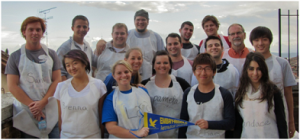
Our entire study abroad group. Picture from Bonnie Pratt. The above picture contains all of the students in our study abroad group including our student aid, Joey, and Dr. Pratt. Not pictured is Professor Pratt’s wife, Bonnie. Dante Alighieri, the Italian institution that we attend for language and culture classes, had us cook because one of the distinguishing features of Siena is the Tuscan cooking style.
We prepared a total of four courses that were crafted from a variety of different ingredients. In Italian, the four dishes we made were sformatino di zucchini, pappardelle con melanzane e funghi, rotolini di tacchino con champignon e limone, and tiramisu alle fragole, which translate roughly to zucchini quiche, pappardelle with eggplant and mushrooms, turkey rolls with mushrooms and lemon, and strawberry tiramisu. Pappardelle is essentially a broad fettuccine noodle. After we finished cooking, we were able to eat our meal.
 Here are some students getting ready to eat. Picture courtesy of Bonnie Pratt. In the above picture, the blond woman is Dr. Pratt’s wife, Bonnie. She’s really nice and a favorite of the students. She enjoyed our meal. The noodles we made were by far the best noodles I have had while in Italy so far. Our meal lasted until around 10 PM at which we returned to our residence and went to bed in preparation for Luca’s class the next day.
Here are some students getting ready to eat. Picture courtesy of Bonnie Pratt. In the above picture, the blond woman is Dr. Pratt’s wife, Bonnie. She’s really nice and a favorite of the students. She enjoyed our meal. The noodles we made were by far the best noodles I have had while in Italy so far. Our meal lasted until around 10 PM at which we returned to our residence and went to bed in preparation for Luca’s class the next day.
My favorite lesson that Luca taught was about the contrade of Siena and the Palio. The contrade are one of the most distinctive features of Siena and originate from the Middle Ages. In the past, Siena had up to 59 contrade, or districts. Currently, however, the city has a total of seventeen contrade. Each ward has its own museum, fountain, church, colors, and symbol. Some even have allies and adversaries. 
The colors and symbol of the Woods contrada. Our residence is located in the Dragon contrada, but we pass through the Goose and Woods contrade on our way to Dante Alighieri, which is located in the Tortoise contrada. The Sienese who live in each area of the city feel very unified, patriotic, and proud of their contrada. For example, one day while I was at the post office, a teenage boy had a tattoo on his leg depicting the flag of his contrada, the Tower. The symbol of the Tower is an elephant with an obelisk on its back.
During our second week in Siena, the Dragon contrada was celebrating one of its holidays. The street was decorated with ornate lights that were painted the colors of the contrada: magenta, green, and gold. Children, teens, and adults alike walked around with their neighborhood’s flag tied around their neck. On the weekend, there was a giant feast that included the entire population of the ward on one of the streets near our residence.
These customs have been practiced for centuries. In the past, the neighborhoods were charged with protecting their fountain, which was the ward’s water supply, and to give men to serve in Siena’s army that protected the city. Today, they serve to enhance and enrich citizens’ cultural identity, allowing them to both remember the past and live in the present. For example, each contrade participates in the Palio, which dates as far back as medieval times.
The Palio horse race is held twice each year on July 2 and August 16. Siena puts quite a bit of money into each race in order to pay for the horses, hire jockeys, purchase decorations, etc. In addition, jockeys are given undisclosed amounts of money to bribe other riders in order to gain some sort of advantage during the Palio. Each race consists of ten horses that are ridden bareback by jockeys dressed in their contrada’s colors.
 The stable of the Eagle contrada. The racetrack goes around the Piazza del Campo, the Siena’s city center. The race circles the Campo three times and typically lasts less than two minutes. Sometimes the goal of the jockeys is to keep the rival contrada from winning and sometimes jockeys are thrown from their horse. Luckily, the winner of the Palio is the first horse that crosses the finish line, not the rider. The loser of the race is considered to be the horse that came in second, not last. This is because the second place horse came so close to winning but failed to do so. We had multiple classes that taught us about the contrade and the Palio. Another part of our classes consisted of visiting different cities in Italy.
The stable of the Eagle contrada. The racetrack goes around the Piazza del Campo, the Siena’s city center. The race circles the Campo three times and typically lasts less than two minutes. Sometimes the goal of the jockeys is to keep the rival contrada from winning and sometimes jockeys are thrown from their horse. Luckily, the winner of the Palio is the first horse that crosses the finish line, not the rider. The loser of the race is considered to be the horse that came in second, not last. This is because the second place horse came so close to winning but failed to do so. We had multiple classes that taught us about the contrade and the Palio. Another part of our classes consisted of visiting different cities in Italy.
During the second week of our studies, we visited two cities, San Gimignano and Venice. San Gimignano, a UNESCO World Heritage Site, is located in the providence of Siena, Tuscany. The walled medieval hill town is famous for its architecture, specifically its towers.
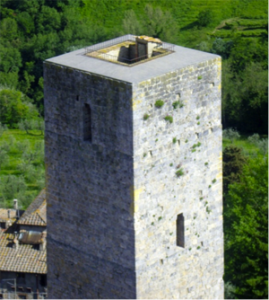 One of San Gimignano’s remaining towers. At one point in time, the city had as many as seventy two towers. The largest of these were around fifty meters tall. It is thought that affluent families would have towers built to show their wealth and supremacy. Currently, however, there are only fourteen towers still standing. The others were taken down due to wear, rebuilding, and wars. In the past, whenever a city was captured, the conquerors would knock down the town’s tower to symbolize the loss of power. During our trip to the city, we took the time to climb up San Gimignano’s tallest tower in order to view the beautiful Tuscan landscape. We could see the rolling hills, neighboring towns, vineyards, and rows upon rows of olive trees.
One of San Gimignano’s remaining towers. At one point in time, the city had as many as seventy two towers. The largest of these were around fifty meters tall. It is thought that affluent families would have towers built to show their wealth and supremacy. Currently, however, there are only fourteen towers still standing. The others were taken down due to wear, rebuilding, and wars. In the past, whenever a city was captured, the conquerors would knock down the town’s tower to symbolize the loss of power. During our trip to the city, we took the time to climb up San Gimignano’s tallest tower in order to view the beautiful Tuscan landscape. We could see the rolling hills, neighboring towns, vineyards, and rows upon rows of olive trees.
 A view of Tuscany from the tallest tower of San Gimignano. Later that same week, we visited Venice. The city is built on top of 118 small islands that are connected by bridges and canals. The city, and the lagoon it rests in, is considered a World Heritage Site.
A view of Tuscany from the tallest tower of San Gimignano. Later that same week, we visited Venice. The city is built on top of 118 small islands that are connected by bridges and canals. The city, and the lagoon it rests in, is considered a World Heritage Site.
 The Grand Canal, one of the main waterways of the city. This picture was taken from the Scalzi Bridge. During the Middle Ages and the Renaissance, Venice was a major maritime power and an important center of commerce due to the city’s location directly on the water. Furthermore, the metropolis was also the origin of many important artistic movements and styles, such as the Renaissance and the Venetian School. Presently, this town is very famous for its Venetian glass and the Carnival of Venice, which is when people wear intricate and beautiful masks.
The Grand Canal, one of the main waterways of the city. This picture was taken from the Scalzi Bridge. During the Middle Ages and the Renaissance, Venice was a major maritime power and an important center of commerce due to the city’s location directly on the water. Furthermore, the metropolis was also the origin of many important artistic movements and styles, such as the Renaissance and the Venetian School. Presently, this town is very famous for its Venetian glass and the Carnival of Venice, which is when people wear intricate and beautiful masks.
During our first day in the city, we visited the Doge’s Palace. The Doge is the title for the chief magistrate and supreme leader of the Republic of Venice. They are elected for life by the aristocracy. The palace was built in the Venetian Gothic style. Originally, it was used to house the Doge, but now the building serves as a landmark and museum.
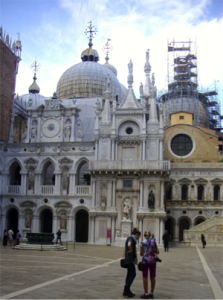 This is a view from the inner courtyard of the Doge’s Palace. My favorite exhibit in the museum was about medieval warfare. The display had many artifacts and was quite expansive. There were full suits of armor for people and horses, swords, daggers, crossbows, guns, spears, and so much more. Since my father loves knights, I grew up adoring castles and watching films about the Middle Ages. I was very disappointed to find out that I was not allowed to take pictures of the collection. I must have spent up to two hours in the museum.
This is a view from the inner courtyard of the Doge’s Palace. My favorite exhibit in the museum was about medieval warfare. The display had many artifacts and was quite expansive. There were full suits of armor for people and horses, swords, daggers, crossbows, guns, spears, and so much more. Since my father loves knights, I grew up adoring castles and watching films about the Middle Ages. I was very disappointed to find out that I was not allowed to take pictures of the collection. I must have spent up to two hours in the museum.
After the Doge’s Palace, I had some free time with which I used to explore Venice. I saw both men and women in brightly colored carnival costumes wearing dresses with huge skirts and white painted masks. If people put euros into the baskets of the festival performers, they could take a picture with them.
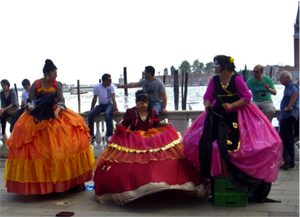 Three people putting on their Carnival of Venice costumes. When I was walking around Venice from island to island across the bridges, I noticed that some of the crossings had locks attached to them. These locks usually had two names written on them and the date of when the lock was placed on the bridge. Sometimes there were even inscriptions about love lasting forever, giving them the name “love locks”.
Three people putting on their Carnival of Venice costumes. When I was walking around Venice from island to island across the bridges, I noticed that some of the crossings had locks attached to them. These locks usually had two names written on them and the date of when the lock was placed on the bridge. Sometimes there were even inscriptions about love lasting forever, giving them the name “love locks”.
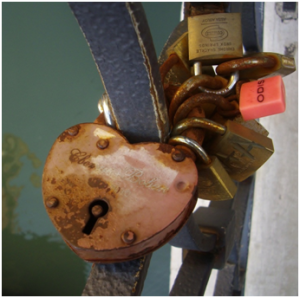 Some of the many love locks that I saw attached bridges. The idea behind the love locks is that two sweethearts engrave their names onto a padlock and attach it to a public fixture such as a bridge, gate, fence, etc. and throw away the key. Since the lock cannot ever be removed, this symbolizes their undying love for each other. While an appealing idea, these love locks are considered to be controversial. Some people do not like them because they build up over time and can affect the aesthetic quality of public places.
Some of the many love locks that I saw attached bridges. The idea behind the love locks is that two sweethearts engrave their names onto a padlock and attach it to a public fixture such as a bridge, gate, fence, etc. and throw away the key. Since the lock cannot ever be removed, this symbolizes their undying love for each other. While an appealing idea, these love locks are considered to be controversial. Some people do not like them because they build up over time and can affect the aesthetic quality of public places.
Thank you for reading this entry and I hope that you thoroughly enjoyed it as well as learned a little bit about Italy.
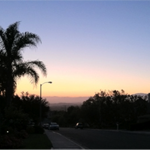 I’ve officially been in California for over a week now; I arrived last Thursday evening safely.
I’ve officially been in California for over a week now; I arrived last Thursday evening safely.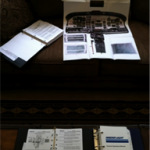 Hazardous Materials (HazMat), GPS training, emergency procedures, company policy/expectations and regulations, to name a few. During the week, the new-hire class got to meet the President, Director of Operations, Chief Pilot, Director of Training, and the Flight Department administration team. Indoc concluded on Friday with a test and receiving our ID badges.
Hazardous Materials (HazMat), GPS training, emergency procedures, company policy/expectations and regulations, to name a few. During the week, the new-hire class got to meet the President, Director of Operations, Chief Pilot, Director of Training, and the Flight Department administration team. Indoc concluded on Friday with a test and receiving our ID badges.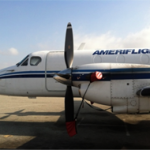 As an intern at Ameriflight, not only do I get paid, but I will also be receiving ground, simulator, and aircraft training to fly the Beechcraft 1900C Airliner as a First Officer (SIC – Second in Command) on daily cargo runs. This is an intense process that will really put my Embry-Riddle education and past flight training to the test. I have already received my training materials (cockpit flow diagram, aircraft manuals, standard operating procedures, etc.) and have begun studying aircraft systems and procedures, as required.
As an intern at Ameriflight, not only do I get paid, but I will also be receiving ground, simulator, and aircraft training to fly the Beechcraft 1900C Airliner as a First Officer (SIC – Second in Command) on daily cargo runs. This is an intense process that will really put my Embry-Riddle education and past flight training to the test. I have already received my training materials (cockpit flow diagram, aircraft manuals, standard operating procedures, etc.) and have begun studying aircraft systems and procedures, as required.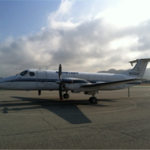 Contrary to public belief, there is a lot of prep-work and studying that goes into being a pilot. As you progress through a career (typically by flying different aircraft), your prior experiences prepare you for the next job, but even the most experienced pilots need to study, as it is a continuous learning process.
Contrary to public belief, there is a lot of prep-work and studying that goes into being a pilot. As you progress through a career (typically by flying different aircraft), your prior experiences prepare you for the next job, but even the most experienced pilots need to study, as it is a continuous learning process.

 This week was spent in the actual airplane flying the line with a training captain, practicing maneuvers and approaches to nearby airports. This allowed me to get a more realistic feel for the airplane and also put my simulator-learned skills to the test. After flying for three days, I was signed off to take my checkride along with a company check-airmen. I took my SIC-First Officer checkride the next day with one of our Beech 1900 check-airmen and passed. Upon completing the flight, I was presented with company wings and first officer epaulets (sometimes know as shoulder bars/strips). Receiving this was such a rewarding feeling, knowing all those hours of study and years of training paid off.
This week was spent in the actual airplane flying the line with a training captain, practicing maneuvers and approaches to nearby airports. This allowed me to get a more realistic feel for the airplane and also put my simulator-learned skills to the test. After flying for three days, I was signed off to take my checkride along with a company check-airmen. I took my SIC-First Officer checkride the next day with one of our Beech 1900 check-airmen and passed. Upon completing the flight, I was presented with company wings and first officer epaulets (sometimes know as shoulder bars/strips). Receiving this was such a rewarding feeling, knowing all those hours of study and years of training paid off. Now that I’m certified to fly the line as a First Officer on the Beech 1900, I have the ability to fly cargo runs anywhere our Beech 1900s fly in the country, but primarily I do in the LA area. Freight-forwarding is a major part of Ameriflight’s business. How UPS and FedEx load their cargo freighters (such as Boeing 767s and Airbus A300s) is via feeder service from smaller cities. Much like how people connect at hubs when flying from one city to another, boxes have to connect as well.
Now that I’m certified to fly the line as a First Officer on the Beech 1900, I have the ability to fly cargo runs anywhere our Beech 1900s fly in the country, but primarily I do in the LA area. Freight-forwarding is a major part of Ameriflight’s business. How UPS and FedEx load their cargo freighters (such as Boeing 767s and Airbus A300s) is via feeder service from smaller cities. Much like how people connect at hubs when flying from one city to another, boxes have to connect as well.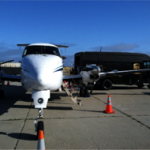
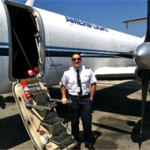


 Here are some students getting ready to eat. Picture courtesy of Bonnie Pratt. In the above picture, the blond woman is Dr. Pratt’s wife, Bonnie. She’s really nice and a favorite of the students. She enjoyed our meal. The noodles we made were by far the best noodles I have had while in Italy so far. Our meal lasted until around 10 PM at which we returned to our residence and went to bed in preparation for Luca’s class the next day.
Here are some students getting ready to eat. Picture courtesy of Bonnie Pratt. In the above picture, the blond woman is Dr. Pratt’s wife, Bonnie. She’s really nice and a favorite of the students. She enjoyed our meal. The noodles we made were by far the best noodles I have had while in Italy so far. Our meal lasted until around 10 PM at which we returned to our residence and went to bed in preparation for Luca’s class the next day.
 The stable of the Eagle contrada. The racetrack goes around the Piazza del Campo, the Siena’s city center. The race circles the Campo three times and typically lasts less than two minutes. Sometimes the goal of the jockeys is to keep the rival contrada from winning and sometimes jockeys are thrown from their horse. Luckily, the winner of the Palio is the first horse that crosses the finish line, not the rider. The loser of the race is considered to be the horse that came in second, not last. This is because the second place horse came so close to winning but failed to do so. We had multiple classes that taught us about the contrade and the Palio. Another part of our classes consisted of visiting different cities in Italy.
The stable of the Eagle contrada. The racetrack goes around the Piazza del Campo, the Siena’s city center. The race circles the Campo three times and typically lasts less than two minutes. Sometimes the goal of the jockeys is to keep the rival contrada from winning and sometimes jockeys are thrown from their horse. Luckily, the winner of the Palio is the first horse that crosses the finish line, not the rider. The loser of the race is considered to be the horse that came in second, not last. This is because the second place horse came so close to winning but failed to do so. We had multiple classes that taught us about the contrade and the Palio. Another part of our classes consisted of visiting different cities in Italy. One of San Gimignano’s remaining towers. At one point in time, the city had as many as seventy two towers. The largest of these were around fifty meters tall. It is thought that affluent families would have towers built to show their wealth and supremacy. Currently, however, there are only fourteen towers still standing. The others were taken down due to wear, rebuilding, and wars. In the past, whenever a city was captured, the conquerors would knock down the town’s tower to symbolize the loss of power. During our trip to the city, we took the time to climb up San Gimignano’s tallest tower in order to view the beautiful Tuscan landscape. We could see the rolling hills, neighboring towns, vineyards, and rows upon rows of olive trees.
One of San Gimignano’s remaining towers. At one point in time, the city had as many as seventy two towers. The largest of these were around fifty meters tall. It is thought that affluent families would have towers built to show their wealth and supremacy. Currently, however, there are only fourteen towers still standing. The others were taken down due to wear, rebuilding, and wars. In the past, whenever a city was captured, the conquerors would knock down the town’s tower to symbolize the loss of power. During our trip to the city, we took the time to climb up San Gimignano’s tallest tower in order to view the beautiful Tuscan landscape. We could see the rolling hills, neighboring towns, vineyards, and rows upon rows of olive trees. A view of Tuscany from the tallest tower of San Gimignano. Later that same week, we visited Venice. The city is built on top of 118 small islands that are connected by bridges and canals. The city, and the lagoon it rests in, is considered a World Heritage Site.
A view of Tuscany from the tallest tower of San Gimignano. Later that same week, we visited Venice. The city is built on top of 118 small islands that are connected by bridges and canals. The city, and the lagoon it rests in, is considered a World Heritage Site. The Grand Canal, one of the main waterways of the city. This picture was taken from the Scalzi Bridge. During the Middle Ages and the Renaissance, Venice was a major maritime power and an important center of commerce due to the city’s location directly on the water. Furthermore, the metropolis was also the origin of many important artistic movements and styles, such as the Renaissance and the Venetian School. Presently, this town is very famous for its Venetian glass and the Carnival of Venice, which is when people wear intricate and beautiful masks.
The Grand Canal, one of the main waterways of the city. This picture was taken from the Scalzi Bridge. During the Middle Ages and the Renaissance, Venice was a major maritime power and an important center of commerce due to the city’s location directly on the water. Furthermore, the metropolis was also the origin of many important artistic movements and styles, such as the Renaissance and the Venetian School. Presently, this town is very famous for its Venetian glass and the Carnival of Venice, which is when people wear intricate and beautiful masks. This is a view from the inner courtyard of the Doge’s Palace. My favorite exhibit in the museum was about medieval warfare. The display had many artifacts and was quite expansive. There were full suits of armor for people and horses, swords, daggers, crossbows, guns, spears, and so much more. Since my father loves knights, I grew up adoring castles and watching films about the Middle Ages. I was very disappointed to find out that I was not allowed to take pictures of the collection. I must have spent up to two hours in the museum.
This is a view from the inner courtyard of the Doge’s Palace. My favorite exhibit in the museum was about medieval warfare. The display had many artifacts and was quite expansive. There were full suits of armor for people and horses, swords, daggers, crossbows, guns, spears, and so much more. Since my father loves knights, I grew up adoring castles and watching films about the Middle Ages. I was very disappointed to find out that I was not allowed to take pictures of the collection. I must have spent up to two hours in the museum. Three people putting on their Carnival of Venice costumes. When I was walking around Venice from island to island across the bridges, I noticed that some of the crossings had locks attached to them. These locks usually had two names written on them and the date of when the lock was placed on the bridge. Sometimes there were even inscriptions about love lasting forever, giving them the name “love locks”.
Three people putting on their Carnival of Venice costumes. When I was walking around Venice from island to island across the bridges, I noticed that some of the crossings had locks attached to them. These locks usually had two names written on them and the date of when the lock was placed on the bridge. Sometimes there were even inscriptions about love lasting forever, giving them the name “love locks”. Some of the many love locks that I saw attached bridges. The idea behind the love locks is that two sweethearts engrave their names onto a padlock and attach it to a public fixture such as a bridge, gate, fence, etc. and throw away the key. Since the lock cannot ever be removed, this symbolizes their undying love for each other. While an appealing idea, these love locks are considered to be controversial. Some people do not like them because they build up over time and can affect the aesthetic quality of public places.
Some of the many love locks that I saw attached bridges. The idea behind the love locks is that two sweethearts engrave their names onto a padlock and attach it to a public fixture such as a bridge, gate, fence, etc. and throw away the key. Since the lock cannot ever be removed, this symbolizes their undying love for each other. While an appealing idea, these love locks are considered to be controversial. Some people do not like them because they build up over time and can affect the aesthetic quality of public places.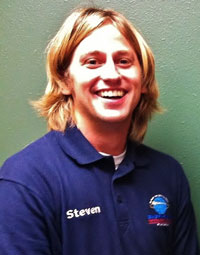 Before I get started about my travels to Siena, Italy and my experiences, I have one order of business to take care of. My previous entry mentioned Steven Bohlemann, a student who works in the Study Abroad Office, but I was not able to get a picture of him in time before I turned the journal admission. As promised, here is a picture of Steven (courtesy of the Study Abroad Office in Daytona Beach).
Before I get started about my travels to Siena, Italy and my experiences, I have one order of business to take care of. My previous entry mentioned Steven Bohlemann, a student who works in the Study Abroad Office, but I was not able to get a picture of him in time before I turned the journal admission. As promised, here is a picture of Steven (courtesy of the Study Abroad Office in Daytona Beach).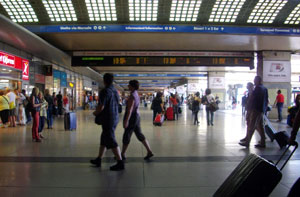 The most nerve wracking event I experienced was when my train was fifteen minutes late. When this occurs, passengers neither know when exactly their train will arrive, nor do they know the platform, or binario, where their train will be located. To make matters worse, I only had a fifteen minute layover between trains in Chiusi Chianciano. Luckily, my delay did not cause me to miss my second train to Siena. After I arrived at the train station, I took a taxi cab to the Residenza San Domenico, the place where students are housed.
The most nerve wracking event I experienced was when my train was fifteen minutes late. When this occurs, passengers neither know when exactly their train will arrive, nor do they know the platform, or binario, where their train will be located. To make matters worse, I only had a fifteen minute layover between trains in Chiusi Chianciano. Luckily, my delay did not cause me to miss my second train to Siena. After I arrived at the train station, I took a taxi cab to the Residenza San Domenico, the place where students are housed. The rooms at Residenza San Domenico are decently furnished. Rooms can house anywhere from two to four students depending on the room. My roommate is a girl from Prescott, Daytona’s sister campus, named Candace. We get along great. No two rooms are alike, but each has a bathroom with a large wardrobe that contains a small kitchenette unit that houses a large sink and hotplate. In addition, silverware, dishes, and cups are provided with the rooms. Some rooms have lofts and others will have large closets and drawers. One of the rooms meant for students has a phenomenal view of neighborhoods across the valley as well as the Duomo, a large gothic church located on of the other hills of Siena.
The rooms at Residenza San Domenico are decently furnished. Rooms can house anywhere from two to four students depending on the room. My roommate is a girl from Prescott, Daytona’s sister campus, named Candace. We get along great. No two rooms are alike, but each has a bathroom with a large wardrobe that contains a small kitchenette unit that houses a large sink and hotplate. In addition, silverware, dishes, and cups are provided with the rooms. Some rooms have lofts and others will have large closets and drawers. One of the rooms meant for students has a phenomenal view of neighborhoods across the valley as well as the Duomo, a large gothic church located on of the other hills of Siena. According to the legend, Romulus, the found of Rome, had two sons, Senius and Aschius. It was these two men who founded Siena. Their colors, white and black, are displayed on the flag of the city and in the colors of the Duomo. On one side, there is an outcropping of red brick and a black and white marble wall. According to my professors, the church was supposed to be much larger than it is today. Work on the expansion halted when Siena was struck by the bubonic plague, which killed about two thirds of the population. I walk by the Duomo every day on the way to class.
According to the legend, Romulus, the found of Rome, had two sons, Senius and Aschius. It was these two men who founded Siena. Their colors, white and black, are displayed on the flag of the city and in the colors of the Duomo. On one side, there is an outcropping of red brick and a black and white marble wall. According to my professors, the church was supposed to be much larger than it is today. Work on the expansion halted when Siena was struck by the bubonic plague, which killed about two thirds of the population. I walk by the Duomo every day on the way to class.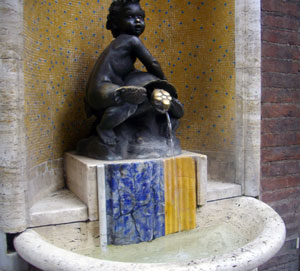 The other class is run by Embry-Riddle. At 9 AM, I take an Italian language class with Massimiliano, an Italian professor. Our learning consists of using a text and workbook along with supplementary lessors. We have learned a lot so far. Typically we have a short 30 minute break at 11AM. This is when most students eat lunch. At 11:30, we either have Massimiliano again or we study Italian culture under Dr. Luca Bonomi, the director of Dante Alighieri. When we have Luca, we usually have a short presentation in class and then he takes us outdoors to walk around and explore Siena. We have visited the Piazza del Campo, which is the city center, as well as the main political buildings. One day, we even analyzed Italian body language and what each of the subtle nuances mean. It was fascinating. After either another session with Massimiliano or Luca, we get another short break of about 15 minutes or so at 1:30 PM. Then we are taught by ERAU professors Dr. Alan Pratt or Dr. Robert Fleck. Dr. Pratt teaches art history, which occurs during the first two weeks of our session. He tries very hard to make sure that we are getting the most out of our studies with daily quizzes that require one word answer and consists of about 15 questions. After Dr. Pratt leaves, we study under Dr. Fleck who teaches Italian contributions to both art and science. Professor Fleck is a high energy teacher. It is quite evident that he is passionate about science. One day, he even tried to draw the solar system on the classroom floor while jumping about in an Einstein t-shirt. He is very entertaining. The end of our day can occur as early as 2:30 PM and as late as 4 PM. It just depends on the day. Luckily, we get three day weekends.
The other class is run by Embry-Riddle. At 9 AM, I take an Italian language class with Massimiliano, an Italian professor. Our learning consists of using a text and workbook along with supplementary lessors. We have learned a lot so far. Typically we have a short 30 minute break at 11AM. This is when most students eat lunch. At 11:30, we either have Massimiliano again or we study Italian culture under Dr. Luca Bonomi, the director of Dante Alighieri. When we have Luca, we usually have a short presentation in class and then he takes us outdoors to walk around and explore Siena. We have visited the Piazza del Campo, which is the city center, as well as the main political buildings. One day, we even analyzed Italian body language and what each of the subtle nuances mean. It was fascinating. After either another session with Massimiliano or Luca, we get another short break of about 15 minutes or so at 1:30 PM. Then we are taught by ERAU professors Dr. Alan Pratt or Dr. Robert Fleck. Dr. Pratt teaches art history, which occurs during the first two weeks of our session. He tries very hard to make sure that we are getting the most out of our studies with daily quizzes that require one word answer and consists of about 15 questions. After Dr. Pratt leaves, we study under Dr. Fleck who teaches Italian contributions to both art and science. Professor Fleck is a high energy teacher. It is quite evident that he is passionate about science. One day, he even tried to draw the solar system on the classroom floor while jumping about in an Einstein t-shirt. He is very entertaining. The end of our day can occur as early as 2:30 PM and as late as 4 PM. It just depends on the day. Luckily, we get three day weekends.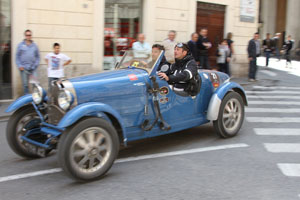 During my first weekend in Siena, while I was walking around with my friend Nathan, I saw an old car race.
During my first weekend in Siena, while I was walking around with my friend Nathan, I saw an old car race.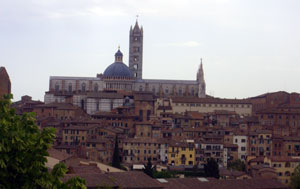

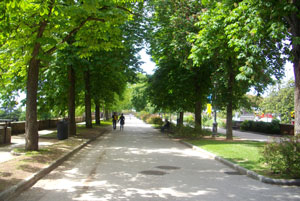
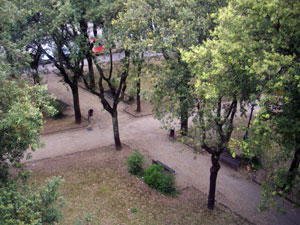
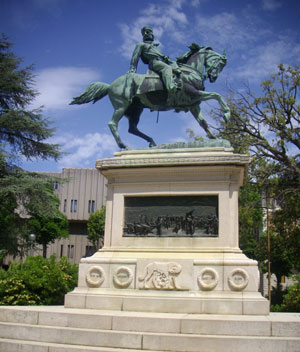
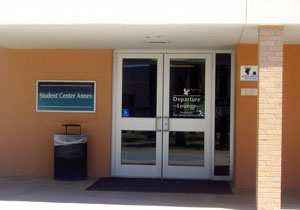 I initially heard of the organization during the fall activities fair that took place near the beginning of first semester. Steven Bohlemann, a student who works in the Study Abroad Office, had a table set up with pictures, posters, and flyers. He was the one who suggested that I look online at the
I initially heard of the organization during the fall activities fair that took place near the beginning of first semester. Steven Bohlemann, a student who works in the Study Abroad Office, had a table set up with pictures, posters, and flyers. He was the one who suggested that I look online at the 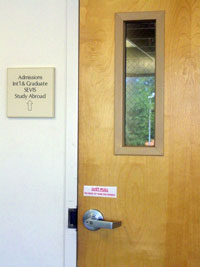 After entering, climb the stairs and look for a plain wooden door almost directly across the room from the staircase. Go through the door and proceed down the hallway until there is a branch to the right that has a sign reading “Study Abroad”.
After entering, climb the stairs and look for a plain wooden door almost directly across the room from the staircase. Go through the door and proceed down the hallway until there is a branch to the right that has a sign reading “Study Abroad”.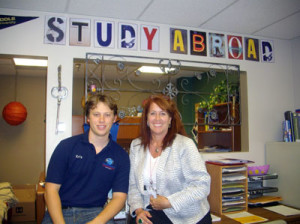 Furthermore, since I am in the Honors Program, Study Abroad also satisfies my HON 350 requirement. I was elated to find out that not only was I able to make my semester course load lighter and more manageable, but studying abroad cost less that attending Summer A on campus at ERAU. I found out this information and other helpful factoids when I attended Study Abroad meetings.
Furthermore, since I am in the Honors Program, Study Abroad also satisfies my HON 350 requirement. I was elated to find out that not only was I able to make my semester course load lighter and more manageable, but studying abroad cost less that attending Summer A on campus at ERAU. I found out this information and other helpful factoids when I attended Study Abroad meetings.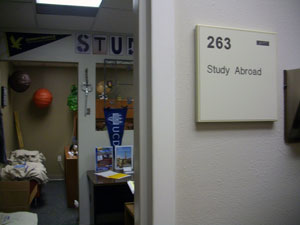 on, I went through my suitcase yet another time to minimize the weight. This will make it easier to travel in Europe, where I will have to haul my own luggage multiple city blocks to get to my destination, Residenza San Domenico. At the end of this week, I will wake up at 4:30am and board an airplane to Houston. The first of three flights to Italy!
on, I went through my suitcase yet another time to minimize the weight. This will make it easier to travel in Europe, where I will have to haul my own luggage multiple city blocks to get to my destination, Residenza San Domenico. At the end of this week, I will wake up at 4:30am and board an airplane to Houston. The first of three flights to Italy!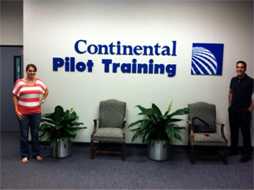 Hello to all my readers out there on the World Wide Web. You might have seen my journals from freshman year or last summer as a Flight Operations Intern at Continental Airlines (now known as United Airlines). Well this summer I will be writing to you about my experiences as Flight Department Intern at Ameriflight, LLC.
Hello to all my readers out there on the World Wide Web. You might have seen my journals from freshman year or last summer as a Flight Operations Intern at Continental Airlines (now known as United Airlines). Well this summer I will be writing to you about my experiences as Flight Department Intern at Ameriflight, LLC.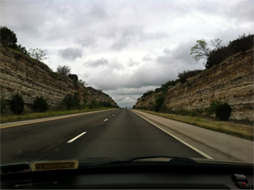 I’m currently on the road to California to begin my summer internship in Burbank (KBUR). I’m making the trip across the country with my Dad, who took the week off of work to share the driving workload with me. We’ve left behind the following states already: Florida, Alabama, Mississippi, Louisiana, Texas, New Mexico, and part of Arizona.
I’m currently on the road to California to begin my summer internship in Burbank (KBUR). I’m making the trip across the country with my Dad, who took the week off of work to share the driving workload with me. We’ve left behind the following states already: Florida, Alabama, Mississippi, Louisiana, Texas, New Mexico, and part of Arizona.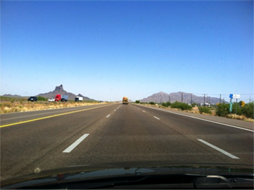 Pilot Training Center at Houston-George Bush Intercontinental Airport (KIAH). Night three was spent in Fort Stockton, Texas (with a slight detour in San Antonio to see the Alamo), as it is a massive state to try to drive through in one day. Night four was spent in Tucson, Arizona where we enjoyed slow cooked barbeque and the grand desert landscape. Leaving Tucson, there was a nearby aircraft bone-yard I got to see from the highway, which was pretty cool. We are almost to the California state boarder and will arrive in Los Angeles this evening.
Pilot Training Center at Houston-George Bush Intercontinental Airport (KIAH). Night three was spent in Fort Stockton, Texas (with a slight detour in San Antonio to see the Alamo), as it is a massive state to try to drive through in one day. Night four was spent in Tucson, Arizona where we enjoyed slow cooked barbeque and the grand desert landscape. Leaving Tucson, there was a nearby aircraft bone-yard I got to see from the highway, which was pretty cool. We are almost to the California state boarder and will arrive in Los Angeles this evening.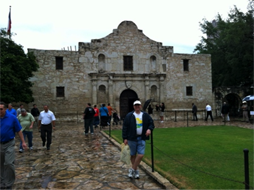
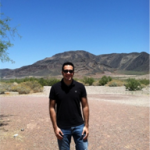
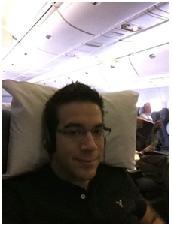 Right now, it’s been two weeks since my last day working at Continental Airlines. The company extends travel privileges for the flight ops interns for 30 days, which is quite nice!
Right now, it’s been two weeks since my last day working at Continental Airlines. The company extends travel privileges for the flight ops interns for 30 days, which is quite nice!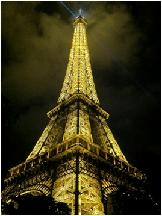 767-400ER and got to sit in BusinessFirst both times!
767-400ER and got to sit in BusinessFirst both times!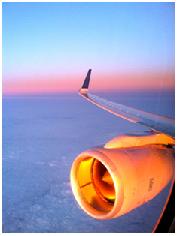 I’m in the process of moving yet again, just like many of us going away to school. I’m now living off-campus and find it to be everything I thought it would be! Moving in and furnishing an apartment has taken a lot of time and money, but I know it will pay off soon. It’s all coming together one piece at a time.
I’m in the process of moving yet again, just like many of us going away to school. I’m now living off-campus and find it to be everything I thought it would be! Moving in and furnishing an apartment has taken a lot of time and money, but I know it will pay off soon. It’s all coming together one piece at a time.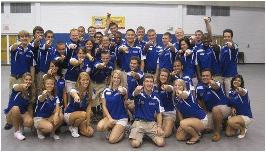 full-time and in addition travelled on the weekends. Meaning I left myself with very little down/spare time. I’ve learned many important lessons this summer on time management. When I say that, I’m not talking about being tardy, but about workload management and setting priorities.
full-time and in addition travelled on the weekends. Meaning I left myself with very little down/spare time. I’ve learned many important lessons this summer on time management. When I say that, I’m not talking about being tardy, but about workload management and setting priorities.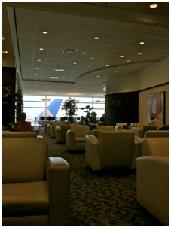 I’m very appreciative to have been offered such an opportunity and writing about it to the world makes it even sweeter! I had such a great time and left with so much knowledge! I truly feel that United/Continental is an excellent company to work for, so much that I hope to one-day work for them again.
I’m very appreciative to have been offered such an opportunity and writing about it to the world makes it even sweeter! I had such a great time and left with so much knowledge! I truly feel that United/Continental is an excellent company to work for, so much that I hope to one-day work for them again.